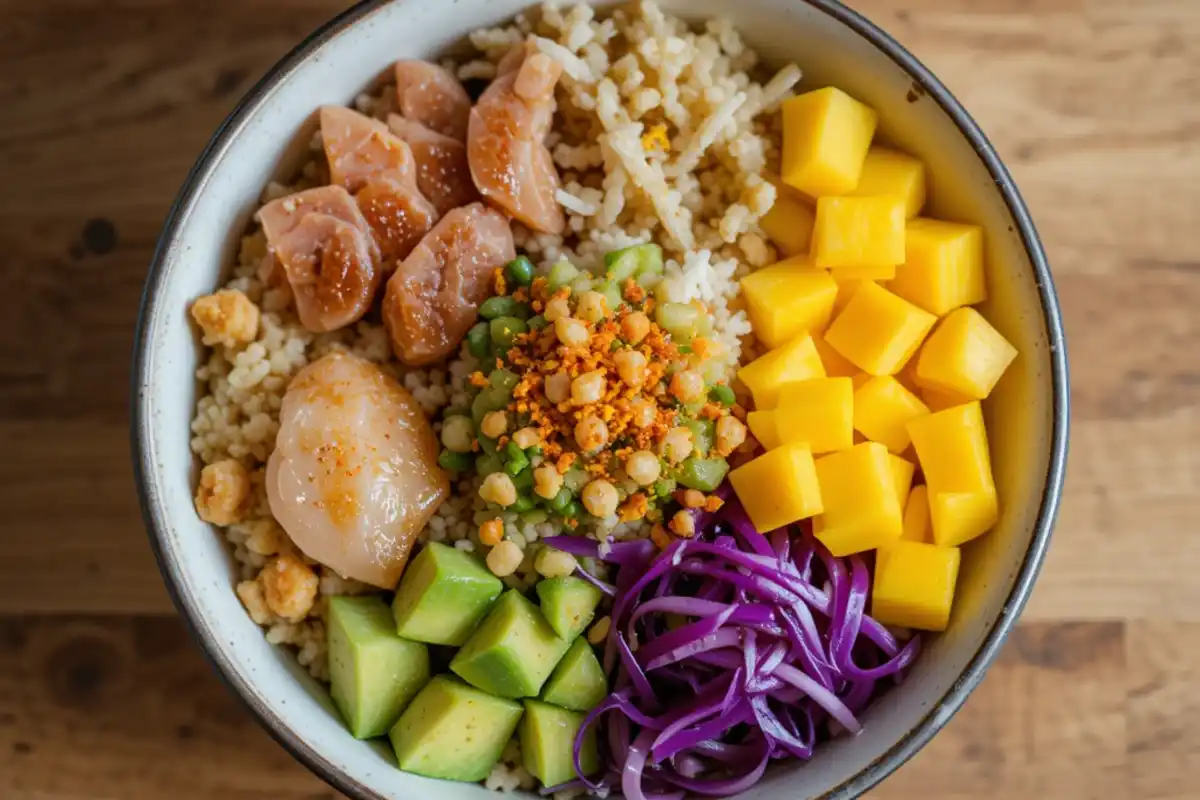Learn how to make a delicious Hawaiian Ahi Tuna poke bowl with fresh ingredients, marinated fish, and creative toppings.
Tuna, salmon, and poke—these words evoke the fresh, vibrant flavors of a Hawaiian poke bowl recipe. A poke bowl is uniquely satisfying, capturing the fresh essence of paradise in every bite. Imagine yourself on a sun-soaked Hawaiian beach, where the gentle sounds of waves mingle with the aroma of fresh seafood.
Poke bowls are more than just a meal; they’re a culinary experience that combines fresh fish, savory marinades, and colorful toppings, all served over a bed of rice. In this guide, we’ll explore the origins of poke, the essential poke bowl ingredients, and provide a detailed, step-by-step ahi tuna poke recipe.
The History of Poke
Origins of Poke:
Before diving into recipes, let’s appreciate the rich history of poke. This beloved dish has its roots in Hawaii, dating back centuries. The word “poke” comes from the Hawaiian verb “to slice,” describing the preparation method. Fishermen traditionally seasoned their catch with sea salt and seaweed, creating a simple yet flavorful dish.
Hawaiian fishermen would often enjoy their catch immediately after it was caught. They would slice the fish into small cubes and mix it with various seasonings, a practice that has evolved into the modern poke bowl we know today. The traditional Hawaiian poke featured ingredients like limu (seaweed) and inamona (a condiment made from roasted kukui nuts), which enhanced the flavor of the fish while connecting it to the land and sea.
Evolution of Poke:
As poke gained popularity, it evolved to include various tastes and ingredients. Today, you can enjoy poke bowls in restaurants and homes globally, each version reflecting local flavors. The rise of sushi culture in the U.S. during the late 20th century introduced a wider audience to raw fish dishes, paving the way for poke to become a mainstream favorite.
With the introduction of fusion cuisine, poke bowls have seen endless variations, incorporating elements from different culinary traditions. Whether you prefer ahi tuna, salmon, or a vegetarian option, poke bowls celebrate freshness and creativity. They allow for personalization, making them perfect for everyone, from health enthusiasts to food adventurers.
Description
Hawaiian poke bowls are a vibrant culinary experience that combines fresh, high-quality fish (like ahi tuna or salmon) with savory marinades and colorful toppings, all served over a base of rice. Originating from Hawaii, poke is a dish that captures the essence of paradise, offering a balance of flavors and textures. A popular variation is the salmon poke recipe, which highlights the rich, buttery texture of salmon.
What Makes a Great Poke Bowl?
A great poke bowl is all about balance. Here are the key elements to consider when crafting your Hawaiian poke bowl:
1. Base
The traditional base is sushi rice, but alternatives like quinoa, brown rice, or mixed greens offer lighter options. The base sets the stage for the flavors and textures that follow. Sushi rice is typically seasoned with rice vinegar, sugar, and salt to give it a slightly sweet and tangy flavor. However, you can customize this to your liking; for a healthier option, brown rice or cauliflower rice can be used.
2. Protein
Tuna and salmon are popular choices, but you can also use cooked shrimp, tofu, or chicken. The protein is the star of the show and should be fresh and high-quality. Sushi-grade fish is essential for safety when eating raw. Look for fish that has been frozen to eliminate parasites, especially if you’re using it raw.
3. Marinade
A good marinade is essential for infusing flavor. Common ingredients include soy sauce, sesame oil, and various seasonings. Marinating the fish not only enhances its flavor but also tenderizes it, making each bite a burst of umami goodness.
4. Toppings
Toppings are a game-changer—don’t underestimate their power! Common choices include avocado, cucumber, seaweed, radishes, and pickled ginger. These toppings add texture, color, and additional flavors, making each bite exciting. Fresh herbs like cilantro or green onions can also brighten the dish.
5. Sauce
A drizzle of sauce like spicy mayo, eel sauce, or ponzu can elevate your poke bowl to new heights. Sauce is where you can get creative; the right sauce can tie all the elements together and provide that extra layer of flavor that makes your bowl unforgettable.
Preparation Time
- Total Time: Approximately 30 minutes
- Rice Preparation: About 20 minutes (including rinsing and cooking)
- Marinating Fish: 5-10 minutes
- Assembly Time: 5 minutes
Essential Ingredients for Your Poke Bowl
Creating a delicious poke bowl requires fresh, high-quality ingredients. Here are the essential components:
Fresh Fish
Fish plays a crucial role in every poke bowl. Tuna and salmon are the most common choices, but you can experiment with other types of fish or plant-based alternatives.
- Tuna: Look for sushi-grade tuna, which is safe to eat raw. Ahi tuna is a popular variety known for its rich flavor and buttery texture. When selecting tuna, aim for bright red color and a firm texture, indicating freshness.
- Salmon: Like tuna, opt for sushi-grade salmon. It harmonizes perfectly with various tastes. Salmon’s natural oils make it a delicious choice for poke, adding richness to the bowl.
- Alternatives: If you can’t find fresh fish, consider using cooked seafood like shrimp or plant-based options such as marinated tofu. These alternatives can still provide that satisfying texture and flavor profile.
Marinades and Sauces
A flavorful marinade can make or break your poke bowl. Here are some popular options:
- Soy Sauce: A classic choice for adding umami flavor. Regular soy sauce works well, but low-sodium varieties are also available for those watching their salt intake.
- Sesame Oil: Lends a nutty aroma; substitute with olive oil if necessary. Toasted sesame oil adds a deeper flavor, enhancing the overall taste of your poke bowl.
- Spicy Mayo: A blend of mayonnaise and Sriracha for a creamy, spicy kick. This sauce is particularly popular and can be drizzled on top or mixed in with the fish.
Toppings
Don’t underestimate the power of toppings! They add texture, color, and additional flavors. Here are some popular choices:
- Avocado: Creamy and rich, it complements the fish beautifully.Rich in healthy fats, avocado enhances the dish with a delightful mouthfeel.
- Cucumber: Adds a refreshing crunch. Thinly sliced cucumber provides a crisp texture that balances the richness of the fish.
- Radishes: For a peppery bite, thinly sliced radishes are an excellent choice. They add a beautiful pop of color and a bit of spice to the dish.
- Pickled Ginger: Pickled ginger adds a tangy touch that elevates the dish. It can also aid digestion, making it a popular accompaniment.
- Seaweed: Nori sheets or wakame can be used to add depth and a hint of the ocean.
How to Make an Easy Hawaiian Ahi Tuna Poke Bowl (Step-by-Step)
Now that you know the essential ingredients, here’s a detailed, step-by-step guide for making a delicious Hawaiian Ahi Tuna poke bowl.
Ingredients
For the Marinade:
- 2 tablespoons shoyu (Japanese soy sauce)
- 2 teaspoons sesame oil
- 2 tablespoons avocado oil
- 1 teaspoon Hawaiian salt
- 1 teaspoon chili flakes
- 2 tablespoons chopped green onions
- 2 cloves chopped garlic
- 1 tablespoon chopped ginger
- 1 cup sliced sweet white onion

For the Bowl:
- 1 lb. raw ahi tuna (or other fish)
- 2 cups cooked sushi rice
- 1 avocado (sliced)
- 1 medium cucumber (sliced)
- 1 cup shredded cabbage or radishes
- Various toppings (e.g., seaweed, mango, jalapenos)
- 2 teaspoons black/white sesame seeds
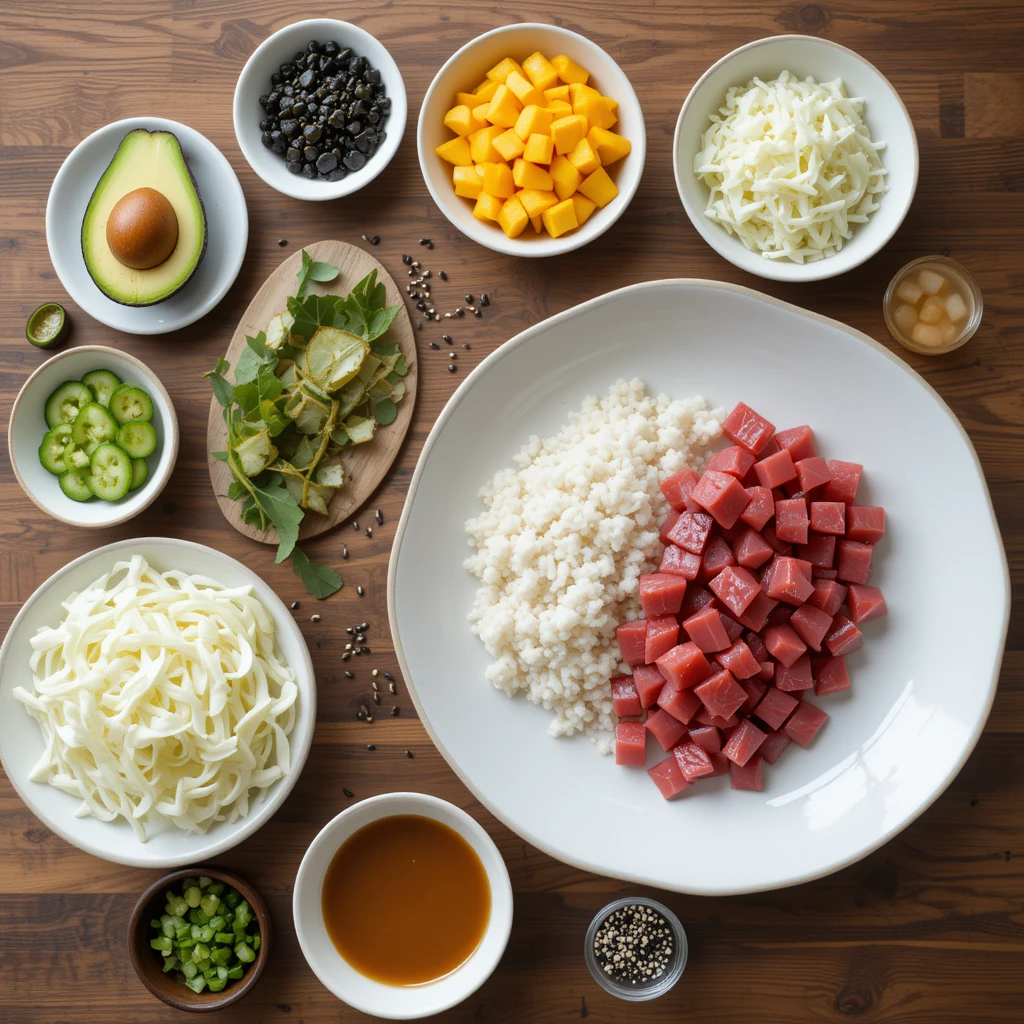
Instructions
- Prepare the Sushi Rice: by rinsing it under cold water until the water is clear. This process removes excess starch, resulting in fluffy and sticky rice. Prepare as directed on the package and keep it warm. When the rice is ready, mix in a bit of rice vinegar to add depth to the flavor.
- Make the Marinade: In a medium bowl, whisk together shoyu, sesame oil, avocado oil, Hawaiian salt, chili flakes, green onions, garlic, ginger, and sweet onion. This marinade will infuse your fish with flavor.
- Marinate the Fish: Dice the raw ahi tuna into small cubes and add it to the marinade, mixing gently. Let it sit for about 5-10 minutes to allow flavors to meld. Be mindful not to overmarinate, as it can change the texture of the fish.
- Assemble the Bowl: In a serving bowl, add a generous scoop of warm sushi rice as the base. Top with marinated tuna, and arrange sliced avocado, cucumber, and shredded cabbage around the fish. Garnish with sesame seeds to provide additional texture.
- Finish and Serve: For an extra touch, drizzle more of the marinade over the bowl or add a spicy mayo sauce. Enjoy your poke bowl right away for the best experience with warm rice!

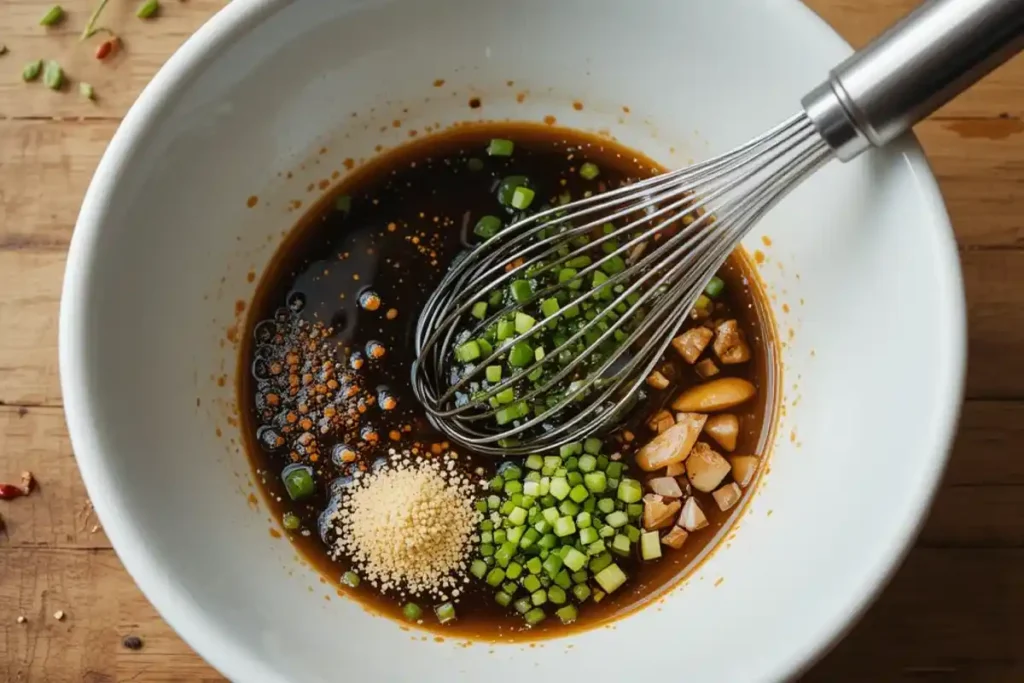
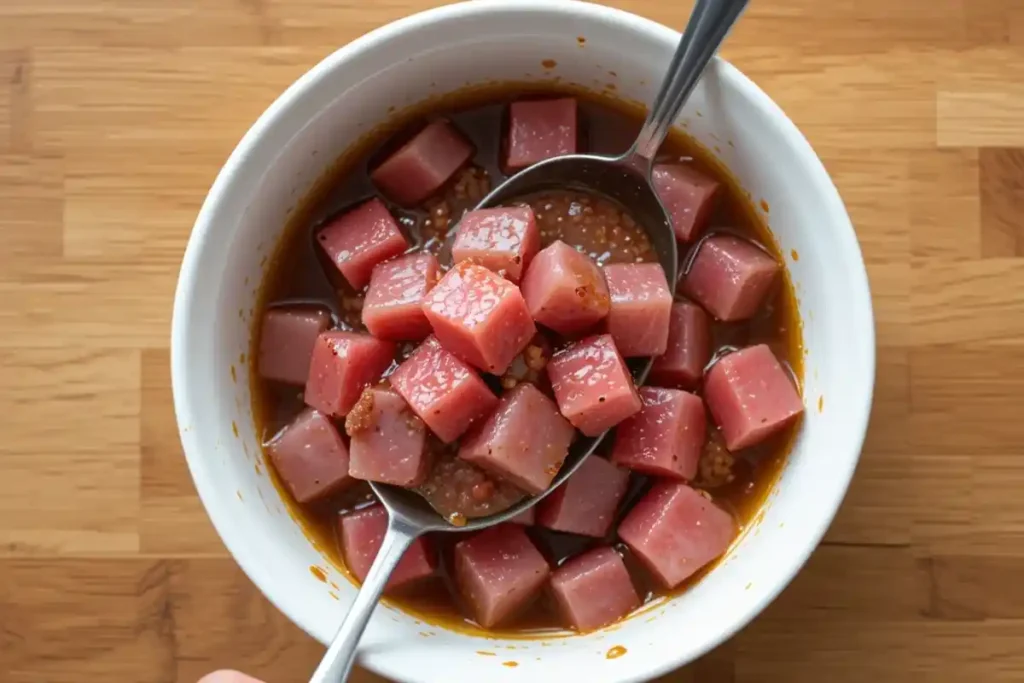
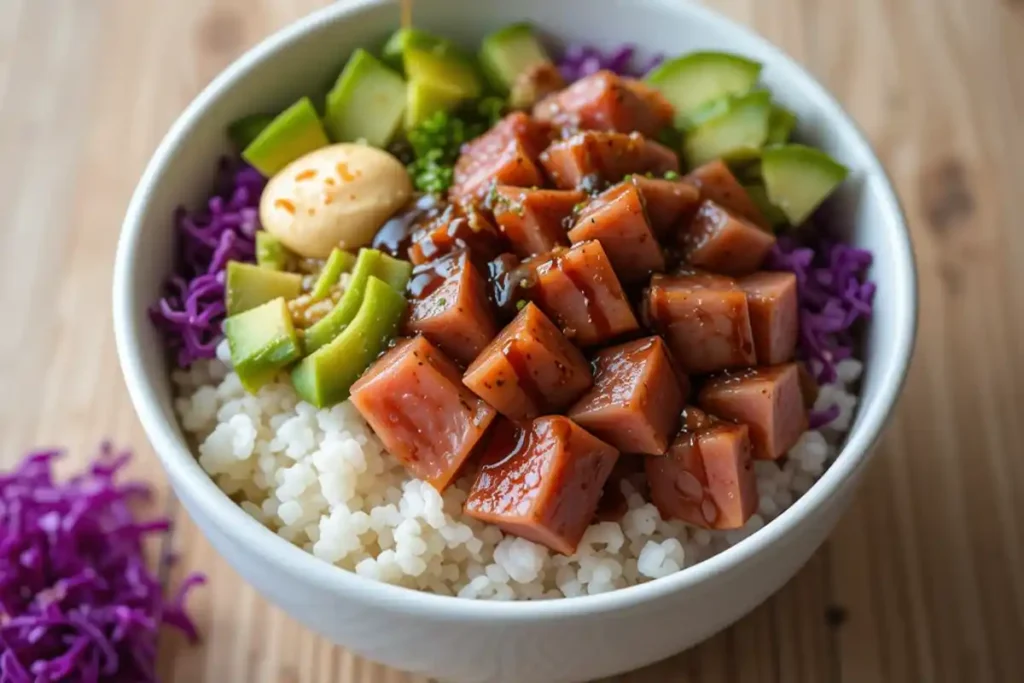
Note
Poke bowls are not just a meal; they are a versatile dish that allows for endless variations, including the salmon poke recipe. Freshness is key, especially when selecting fish, as sushi-grade ingredients ensure both safety and flavor. Keep in mind the poke bowl calories, as they can vary significantly based on the ingredients and portion sizes.
Tips for Success
- Choose Quality Fish: Always buy sushi-grade fish from a reputable source. Freshness is key for safety and flavor. If you’re unsure, don’t hesitate to ask your fishmonger about the best options.
- Don’t Overmarinate: Keep an eye on marinating time; typically, 5-10 minutes is sufficient to infuse flavor without compromising the fish’s quality. If cooked for too long, the fish may become overly soft and mushy.
- Serve Immediately: Poke bowls are best enjoyed fresh. If meal prepping, store components separately to maintain the integrity of each ingredient.
- Experiment with Flavors: Get creative with different sauces and toppings to find your perfect combination. Consider adding fruit for sweetness or spicy elements for heat.
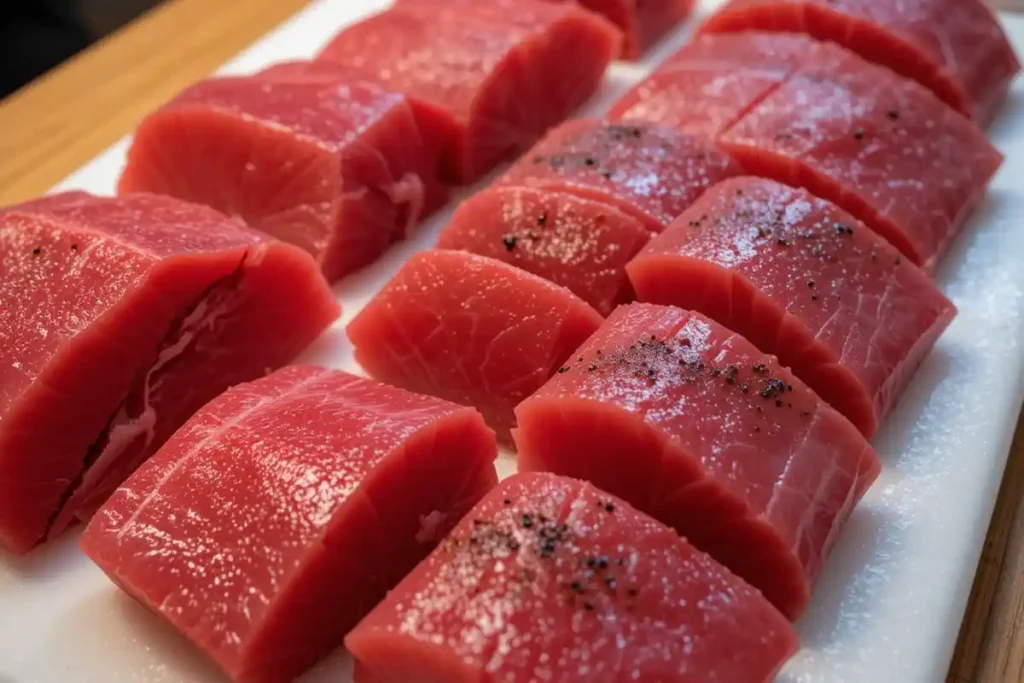
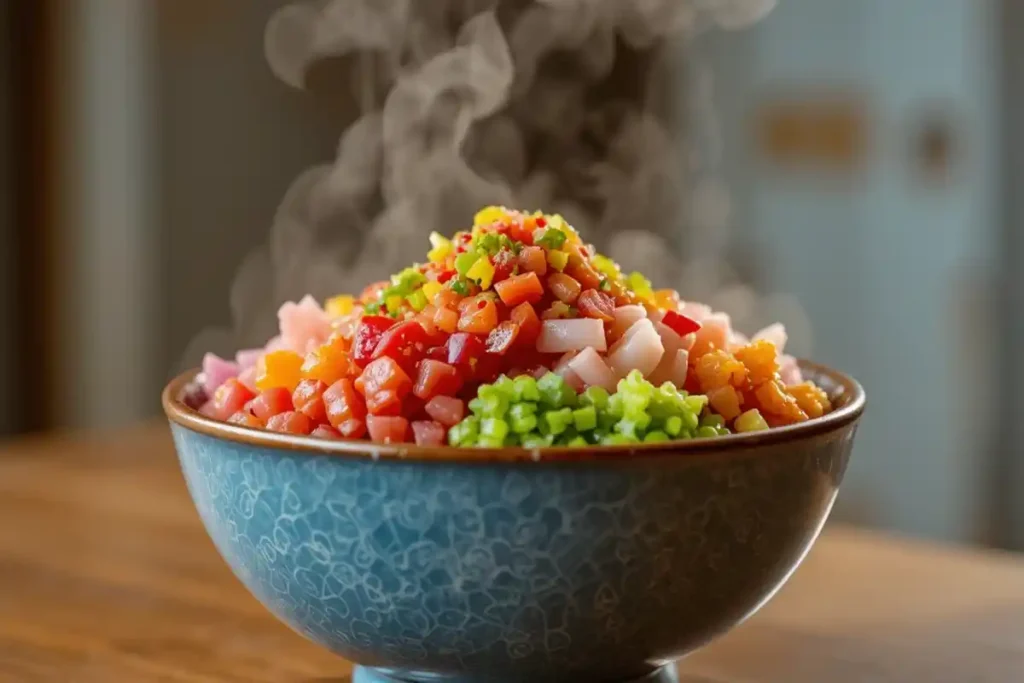
Variations and Customizations
What makes poke bowls special is their flexibility. Here are some fun variations:
Vegetarian Poke Bowl
Substitute fish with marinated tofu or tempeh for a plant-based alternative. Marinate the tofu in similar flavors to achieve a satisfying experience.
Spicy Tuna Poke
Mix mayonnaise with Sriracha for a spicy mayo sauce, drizzling it over your poke bowl for an extra burst of flavor. Modify the spiciness to match your personal preference.
Tropical Twist
Incorporate diced mango or pineapple to create a sweet contrast with the savory elements. These tropical ingredients can add a refreshing sweetness that complements the fish perfectly.
Keto-Friendly
Skip the rice and use a base of mixed greens or cauliflower rice for a satisfying low-carb meal. This option retains the wonderful flavors of the poke while reducing carbohydrates.
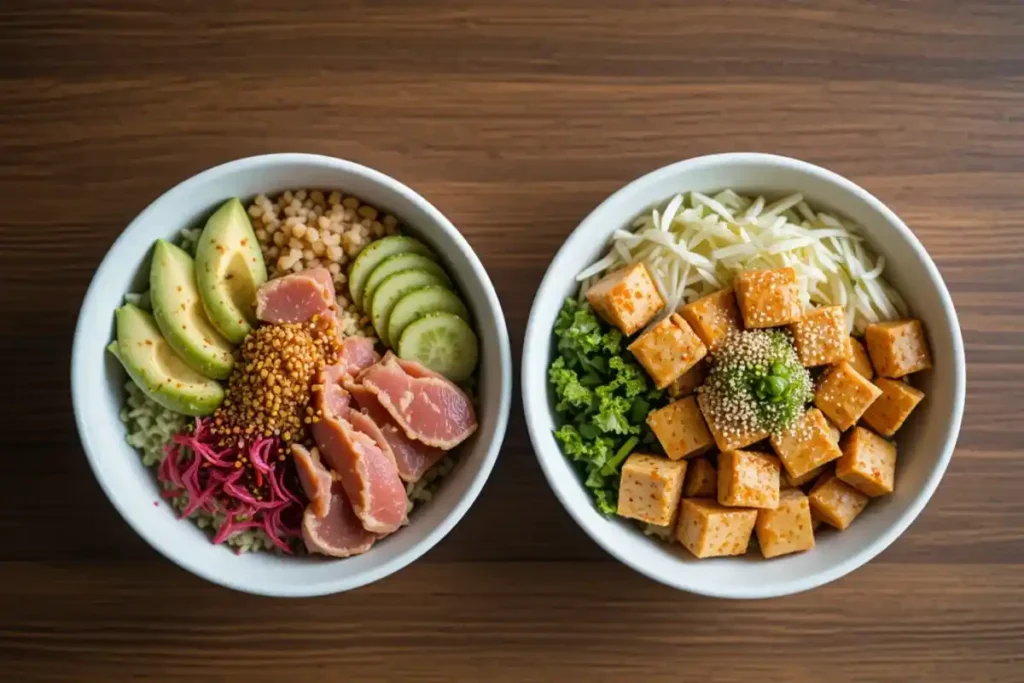

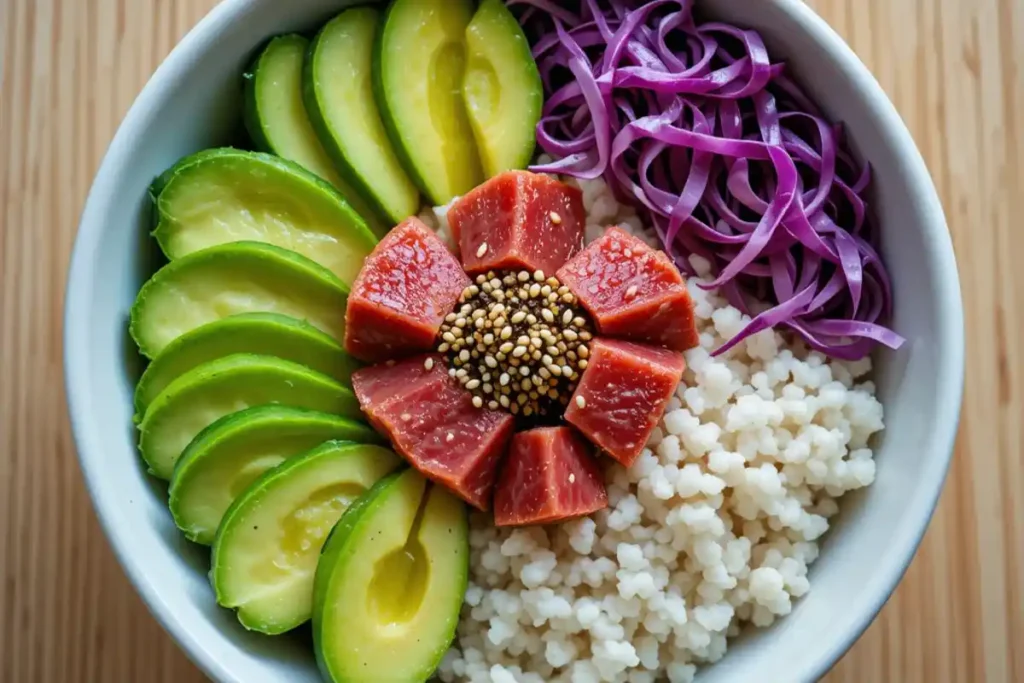
Storage and Reheating Instructions
Store leftover poke bowl components separately in airtight containers. Fish lasts up to 24 hours in the fridge, while rice and toppings last 2-3 days. Reheat rice before serving, but enjoy fish cold for the best texture. If you have marinated leftovers, use them within a day for optimal freshness.
Serving Suggestions
Pair your poke bowl with refreshing sides for a complete meal:
- Miso Soup: Complements the freshness of the poke. The dish is both light and comforting, making it an ideal match.
- Seaweed salad: introduces an additional dimension of flavor and texture. The umami derived from the seaweed enhances the flavor profile significantly.
- Edamame: A healthy snack option, steamed and lightly salted. Edamame provides a protein boost and adds a delightful crunch.
Nutrition Value (per serving, approximate)
- Serving Size: 1 bowl (approximately 300-400g)
- Calories: 500-600
- Total Sugar: 2-5g (varies with toppings like avocado and sauces)
- Sodium: 800-1000mg (primarily from soy sauce and other seasonings)
- Saturated Fat: 3-5g (mainly from fish and avocado)
- Unsaturated Fat: 15-20g (from avocado and oils)
- Trans Fat: 0g (if using fresh ingredients)
- Total Carbohydrates: 50-70g (depending on rice type)
- Fiber: 5-7g (from vegetables and toppings)
- Protein: 30-40g (depending on the type and amount of fish used)
- Cholesterol: 60-80mg (from fish)
Frequently Asked Questions (FAQs)
What is a poke bowl?
A poke bowl is a classic Hawaiian dish made with cubed raw fish (like ahi tuna) served over rice and topped with various ingredients. This meal is adaptable, allowing for an infinite array of combinations.
Can I use cooked fish for a poke bowl?
Yes, you can use cooked fish if you prefer. However, traditional poke bowls are made with raw fish for the best flavor and texture. If you choose cooked fish, consider options like grilled shrimp or crab.
How do I choose the right fish for my poke bowl?
Look for sushi-grade fish from reputable sellers. Ahi tuna, salmon, and yellowfin tuna are popular choices. Always ask about freshness and sourcing to ensure quality.
Are poke bowls healthy?
Poke bowls can be a healthy choice, rich in protein and vitamins from fresh vegetables. Be mindful of sauces and portion sizes, as they can add hidden calories.
Can I make poke bowls in advance?
You can prepare components in advance, but it’s best to assemble the bowl just before serving to maintain freshness. Keep fish and toppings stored separately to prevent sogginess.
Related Recipes
- Spicy Salmon Poke Bowl: A delicious variation featuring salmon with a spicy twist. This version is ideal for those who appreciate a little kick.
- Vegetarian Tofu Poke Bowl: A plant-based take on the poke bowl. This recipe is packed with flavor and can easily satisfy vegetarians and meat-eaters alike.
- Shrimp Poke Bowl: Fresh shrimp provides a seafood alternative that’s equally satisfying. Perfect for a healthy meal, this dish is both light and refreshing.
You’ve now journeyed through the world of Hawaiian poke bowls, from their rich history to crafting your perfect bowl. Tuna, salmon, poke—these are not just ingredients; they represent a culinary experience you can enjoy at home. With endless variations and the freedom to customize, poke bowls are perfect for any meal, whether a quick lunch or a fancy dinner.
So gather your ingredients, unleash your creativity, and enjoy the process of making and savoring your very own poke bowl masterpiece! Whether you’re hosting a gathering or enjoying a quiet meal at home, poke bowls offer a delightful journey through flavors, textures, and experiences that celebrate the essence of Hawaiian cuisine.
Print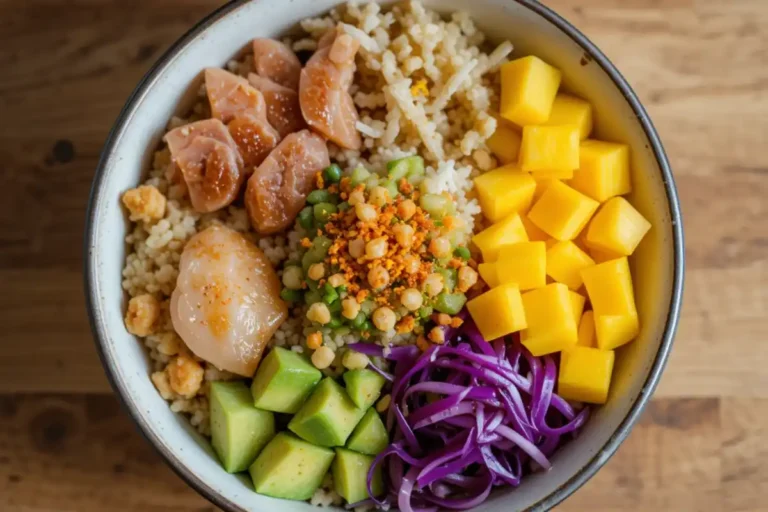
Hawaiian Poke Bowls: Mouthwatering Recipes & Tips for a Flavorful Feast.
Hawaiian poke bowls are a vibrant culinary experience that combines fresh, high-quality fish (like ahi tuna or salmon) with savory marinades and colorful toppings, all served over a base of rice. Originating from Hawaii, poke is a dish that captures the essence of paradise, offering a balance of flavors and textures. A popular variation is the salmon poke recipe, which highlights the rich, buttery texture of salmon.
- Total Time: 30 minutes
- Yield: 1 bowl (approximately 300-400g) 1x
Ingredients
For the Marinade:
- 2 tablespoons shoyu (Japanese soy sauce)
- 2 teaspoons sesame oil
- 2 tablespoons avocado oil
- 1 teaspoon Hawaiian salt
- 1 teaspoon chili flakes
- 2 tablespoons chopped green onions
- 2 cloves chopped garlic
- 1 tablespoon chopped ginger
- 1 cup sliced sweet white onion
For the Bowl:
- 1 lb. raw ahi tuna (or other fish)
- 2 cups cooked sushi rice
- 1 avocado (sliced)
- 1 medium cucumber (sliced)
- 1 cup shredded cabbage or radishes
- Various toppings (e.g., seaweed, mango, jalapenos)
- 2 teaspoons black/white sesame seeds
Instructions
- Prepare the Sushi Rice: by rinsing it under cold water until the water is clear. This process removes excess starch, resulting in fluffy and sticky rice. Prepare as directed on the package and keep it warm. When the rice is ready, mix in a bit of rice vinegar to add depth to the flavor.
- Make the Marinade: In a medium bowl, whisk together shoyu, sesame oil, avocado oil, Hawaiian salt, chili flakes, green onions, garlic, ginger, and sweet onion. This marinade will infuse your fish with flavor.
- Marinate the Fish: Dice the raw ahi tuna into small cubes and add it to the marinade, mixing gently. Let it sit for about 5-10 minutes to allow flavors to meld. Be mindful not to overmarinate, as it can change the texture of the fish.
- Assemble the Bowl: In a serving bowl, add a generous scoop of warm sushi rice as the base. Top with marinated tuna, and arrange sliced avocado, cucumber, and shredded cabbage around the fish. Garnish with sesame seeds to provide additional texture.
- Finish and Serve: For an extra touch, drizzle more of the marinade over the bowl or add a spicy mayo sauce. Enjoy your poke bowl right away for the best experience with warm rice!
Notes
Poke bowls are not just a meal; they are a versatile dish that allows for endless variations, including the salmon poke recipe. Freshness is key, especially when selecting fish, as sushi-grade ingredients ensure both safety and flavor. Keep in mind the poke bowl calories, as they can vary significantly based on the ingredients and portion sizes.
- Prep Time: 20 minutes
- Cook Time: 5-10 minutes
- Category: lunch
- Cuisine: Hawaiian
Nutrition
- Serving Size: 1 bowl (approximately 300-400g)
- Calories: 500-600
- Sugar: 2-5g
- Sodium: 800-1000mg
- Fat: 3-5g
- Saturated Fat: 3-5g
- Unsaturated Fat: 15-20g
- Trans Fat: 0g
- Carbohydrates: 50-70g
- Fiber: 5-7g
- Protein: 30-40g
- Cholesterol: 60-80mg
Keywords: salmon poke poke bowl

